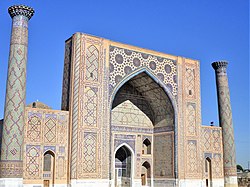Timurid Empire
The Timurid Empire was a Persian and Turco-Mongol[2] empire that included all of Uzbekistan, Iran, modern Afghanistan, and modern Central Asia. It also included large parts of modern Pakistan, Mesopotamia, Anatolia and the Caucasus. It was formed by the Turco-Mongol conqueror Timur (Tamerlane) of the Timurid dynasty in the 14th century.
Timurid Empire تیموریان | |||||||||||||||||||
|---|---|---|---|---|---|---|---|---|---|---|---|---|---|---|---|---|---|---|---|
| 1370–1526 | |||||||||||||||||||
 Timurid Empire at its greatest extent | |||||||||||||||||||
| Status | Empire in Middle east and Central Asia | ||||||||||||||||||
| Capital | Samarkand, Herat | ||||||||||||||||||
| Common languages | Chaghatai & Persian | ||||||||||||||||||
| Religion | Islam | ||||||||||||||||||
| Government | Monarchy | ||||||||||||||||||
| Emir | |||||||||||||||||||
• 1370–1405 | Timur | ||||||||||||||||||
• 1506–1507 | Muzaffar Hussayn | ||||||||||||||||||
| Historical era | Medieval | ||||||||||||||||||
• | 1370 | ||||||||||||||||||
• Samarkand conquered by Uzbeks under Muhammad Shaybani | 1509 | ||||||||||||||||||
• Herat conquered by Shaybani | 1507 | ||||||||||||||||||
• | 1526 | ||||||||||||||||||
| Area | |||||||||||||||||||
• Total | [convert: invalid number] | ||||||||||||||||||
| 1405 est.[1] | 4,400,000 km2 (1,700,000 sq mi) | ||||||||||||||||||
| |||||||||||||||||||
a: Flag of the Timurid Empire according to the Catalan Atlas c. 1375 | |||||||||||||||||||
Timurid Empire Media
Battle between Timur (left) and Tokhtamysh (right), 1420–1440, possibly Herat. Topkapi H.2153.
Contemporary depiction of the Qara Qoyunlu forces of Qara Iskandar (left) in battle against the Timurid forces of Ibrahim Sultan (right) in April 1429. Shahnama of Ibrahim Sultan (c.1430) frontispiece.
Earliest known portrait of Timur, commissionned right after his death in 1405-1409, by his grandson Khalil Sultan.
Frontispiece from the Cairo Bustan, depicting Sultan Husayn Bayqara and his court. Herat, c. 1488
The Mira‘j nama was commissioned by Shahrukh and composed in 1436 in Chaghatai Turkic using the Uighur script, c.1436 in Herat. The multi-headed deity is inspired from the Chinese Buddhist Avalokitesvara.
Tumurid mo'araq mosaic. Ulugh Beg Madrasa, Samarkand, 1417-1421
Façade of the Ulugh Beg Madrasa at the Registan in Samarkand (1417–1420). The two other buildings of the Registan date from the Khanate of Bukhara in the 17th century.
Coinage of Timur with "three annulets" symbol (at the center of the reverse side). Shaykh abu-Ishaq (Kazerun) mint. Undated, c. AH 795–807; AD 1393–1405.
Related pages
References
- ↑ Turchin, Peter; Adams, Jonathan M.; Hall, Thomas D (December 2006). "East-West Orientation of Historical Empires" (PDF). Journal of World-systems Research. 12 (2): 219–229. doi:10.5195/jwsr.2006.369. ISSN 1076-156X. Archived from the original (PDF) on 22 February 2007. Retrieved 12 August 2010.
- ↑ Maria Subtelny, "Timurids in Transition", BRILL; illustrated edition (2007-09-30). pg 40: "Nevertheless, in the complex process of transition, members of the Timurid dynasty and their Turko-Mongol supporters became acculturate by the surrounding Persinate millieu adopting Persian cultural models and tastes and acting as patrons of Persian culture, painting, architecture and music." pg 41: "The last members of the dynasty, notably Sultan-Abu Sa'id and Sultan-Husain, in fact came to be regarded as ideal Perso-Islamic rulers who develoted as much attention to agricultural development as they did to fostering Persianate court culture."










